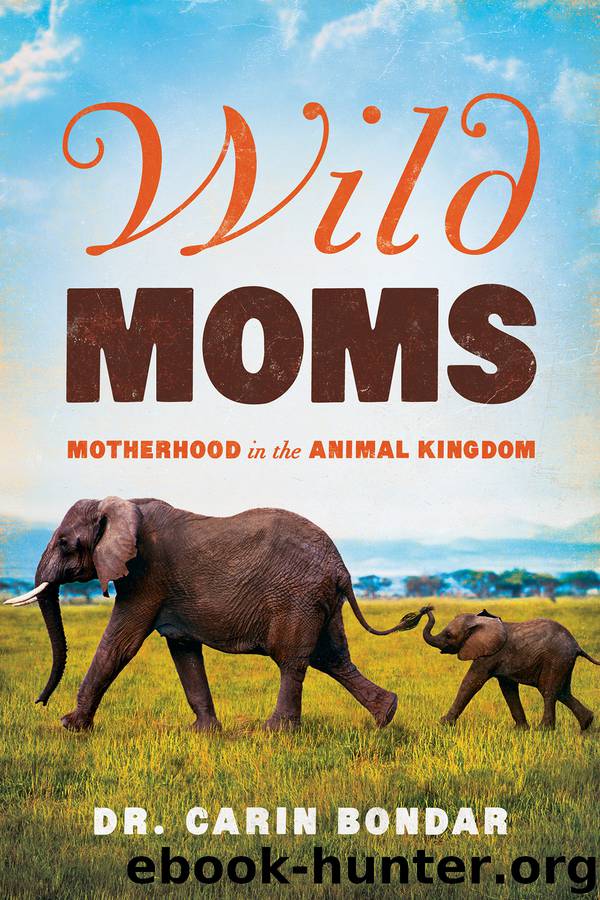Wild Moms by Carin Bondar

Author:Carin Bondar
Language: eng
Format: epub
Publisher: Pegasus Books
Published: 2018-03-03T16:00:00+00:00
11
OPPORTUNISTIC ORPHANS AND MAGNANIMOUS MOMS
Moms can employ a number of strategies to ensure that their young are adequately fed during their first few months of life, and many of these involve providing help to other moms by sharing in the lactational responsibilities. Termed allonursing, we know it as wet-nursing—the act of providing milk to newborns that are not one’s own—and it’s very common in the mammalian world. To date, allonursing has been observed in sixty-eight different species across all major mammalian groups, which indicates that it is adaptive for a wide variety of mammals in a wide variety of situations. In addition to the obvious nutritional benefits of allonursing, infants suckling from multiple females (in any group situation) obtain the benefits of increased diversity in immune factors transferred from each lactating female.
Since the act of milk sharing between females is so common, a variety of hypotheses attempt to explain its existence. It’s likely that milk sharing has independently developed in a number of mammals to suit the unique biological and ecological niches of various species, and there are many good reasons for doing so. Keep in mind that lactation is an exceedingly expensive process for females, requiring more energy than the actual process of gestation. In light of this, making the decision to share milk—an important and expensive resource—is not a trivial one.
Among the most supported hypotheses for doing so is the kin selection hypothesis, which simply states that mothers are more likely to share these expensive resources with the offspring of close relatives. One’s overall inclusive fitness can be increased by providing sustenance to related newborns. This kind of action is observable in collective breeders like meerkats and mongooses, in which many of the females providing the allonursing service are doing so for the offspring of their dominant mother; hence feeding their sisters and brothers. Even non-reproductive females of several species spontaneously lactate and feed related young when the situations present.
The related social benefit hypothesis is limited to situations in which a significant gain in social standing can be derived from suckling someone else’s offspring. In cooperatively breeding groups, there is often a discrete social hierarchy to which most members adhere. There are both singular (where only one mother reproduces and creates all the babies for a given group) or plural (where two or more females in a cooperative group are reproductive) cooperative breeding groups. Although in the plural groups many females may be reproductive, the social hierarchy still exists, and low-ranking females may still provide an allonursing service to the offspring of high-ranking females to gain the social benefit. It is unlikely that the high-ranking females return the favor. Instead, allonursing provides a way for low-ranking females to show their subordinate status and presumably gain the social favor of those higher on the social scale.
In other group-living situations, such of those of African and Indian elephants, more than one female may be reproductive without the existence of such a notable hierarchy. Such societies are matrilineal, with mothers, sisters, and offspring forming tight-knit groups.
Download
This site does not store any files on its server. We only index and link to content provided by other sites. Please contact the content providers to delete copyright contents if any and email us, we'll remove relevant links or contents immediately.
| Amphibians | Animal Behavior & Communication |
| Animal Psychology | Ichthyology |
| Invertebrates | Mammals |
| Ornithology | Primatology |
| Reptiles |
Sapiens: A Brief History of Humankind by Yuval Noah Harari(13052)
The Tidewater Tales by John Barth(12029)
Do No Harm Stories of Life, Death and Brain Surgery by Henry Marsh(6336)
Mastermind: How to Think Like Sherlock Holmes by Maria Konnikova(6235)
The Thirst by Nesbo Jo(5785)
Why We Sleep: Unlocking the Power of Sleep and Dreams by Matthew Walker(5641)
Sapiens by Yuval Noah Harari(4536)
Life 3.0: Being Human in the Age of Artificial Intelligence by Tegmark Max(4507)
The Longevity Diet by Valter Longo(4445)
The Rules Do Not Apply by Ariel Levy(3905)
The Immortal Life of Henrietta Lacks by Rebecca Skloot(3826)
The Body: A Guide for Occupants by Bill Bryson(3800)
Why We Sleep by Matthew Walker(3771)
Animal Frequency by Melissa Alvarez(3755)
Yoga Anatomy by Kaminoff Leslie(3701)
Barron's AP Biology by Goldberg M.S. Deborah T(3631)
The Hacking of the American Mind by Robert H. Lustig(3579)
All Creatures Great and Small by James Herriot(3515)
Yoga Anatomy by Leslie Kaminoff & Amy Matthews(3395)
